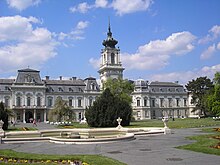Viktor Rumpelmayer
Viktor Rumpelmayer (also Rumpelmeyer, born November 7, 1830 in Preßburg , † June 14, 1885 in Vienna ) was an Austrian architect of the 19th century.
Life
The son of a master stonemason first completed an apprenticeship with his father. In 1847 he moved to Munich and was a guest student at the polytechnic school . 1849-1853 he studied architecture at the Academy of Fine Arts in Munich a . a. with Ludwig Lange .
After graduating, there followed a longer stay in Paris, which was to be of importance for his later creative work, especially in interior design. As an architect, he initially worked at the world exhibitions in London in 1862 and Paris in 1867 . In Paris he built the "Portuguese Pavilion". In the mid-1860s he came to Vienna and worked for the architects Eduard van der Nüll and August Sicard von Sicardsburg , where he a. a. the construction of the first Haas House was involved. He then went into business for himself and founded his own studio in 1872. He built a number of representative city palaces and residential buildings in Vienna and Pressburg in the so-called Ringstrasse style . There were also projects outside of Austria , such as in Hungary (Festetics Palace in Keszthely ) and for Prince Alexander I. Battenberg in Bulgaria (reconstruction of the Prince's Palace in Sofia and the Euxinograd Summer Palace on the Black Sea coast).
Rumpelmayer died in 1885 at the age of 55 and was buried in the Andreas Cemetery in Bratislava . His wife Luise (1848–1890) followed him. The grave stele designed in neo-Gothic style has been preserved and is entered in the Bratislava List of Monuments .
Buildings and projects
- 1872 Palais Sigray St. Marsan , Vienna, Sankt Marsan 3, Jauresgasse 9; today Iranian embassy
- 1873 British ambassador's residence, Metternichgasse 6, Jauresgasse 8
- 1874–1876 "Lloyd-Hof", Praterstrasse 11, 13, 15
- 1875–1887 Christ Church Vienna , Vienna, Jaurèsgasse 17–21
- 1875 Palais Figdor , Löwelstraße 8, built for the Figdor family , today the seat of the embassies of Lichtenstein and Spain
- 1878–1882 Royal Palace (now the National Gallery ) in Sofia
- 1878 Palais Nathaniel Rothschild , Vienna, Plößlgasse 8, apparently together with other architects
- 1879 Embassy palace of the Imperial German Embassy , Rennweg, (1938-145 rebuilt according to plans by Josef Hoffmann , demolished 1957-58 after bomb damage).
- 1880 Palais Rosa Hohenlohe-Bartenstein , today the Belgian Embassy, Vienna, Schönburgstrasse 8-10
- 1880 Palais Apponyi , Vienna, Johann-Strauss-Gasse 7
- 1880 Mietpalais 4, Vienna, Schwindgasse 4
- 1880 Reconstruction of the Festetics Palace in Keszthely on Lake Balaton
- 1881–1883 Marienkirche, Berndorf
- 1885 Palais Pálffy , Pressburg, Panska Street
- 1890–91 Euxinograd Castle , former summer residence of the Bulgarian tsars on the Black Sea .
Awards
- 1868 Knight of the French Legion of Honor
- 1881 Knight of the Prussian Red Eagle Order 4th class.
- Golden Cross of Merit
- Knight of the Portuguese Order of Our Lady of Villa Vicosa
literature
- Ulrich Thieme , Felix Becker [ed.]: General lexicon of visual artists from antiquity to the present. 37 volumes. Leipzig: Engelmann 1907–1950
- Géza Hajós , Walther Brauneis : The secular buildings of the 3rd, 4th and 5th district. Vienna: Schroll 1980 (Österreichische Kunsttopographie, 44.2), p. 386
- Federal Monuments Office [ed.]: Dehio manual . The art monuments of Austria. Vienna. X. to XIX. and XXI. to XXIII. District. Vienna 1993, p. 47, p. 85, p. 112, p. 120 f., P. 152, p. 176, p. 186, p. 195
- Paul Kortz: Vienna at the beginning of the 20th century. A guide in a technical and artistic direction. Edited by the Austrian Association of Engineers and Architects. Volume 2. Vienna: Gerlach & Wiedling 1906, p. 12, p. 20, p. 395 f., P. 421, p. 433
- Technical guide through Vienna. Edited by the Austrian Association of Engineers and Architects. Edited by Martin Paul. Vienna: Gerlach & Wiedling 1910 (register)
- Deutsche Bauzeitung 11 (1877), p. 102 ff.
- Neues Wiener Tagblatt , June 15, 1885
- Illustrated Wiener Extrablatt , June 16, 1885
- M. Stern: Rumpelmayer Viktor. In: Austrian Biographical Lexicon 1815–1950 (ÖBL). Volume 9, Verlag der Österreichischen Akademie der Wissenschaften, Vienna 1988, ISBN 3-7001-1483-4 , p. 325.
Individual evidence
- ↑ Hans-Joachim Böttcher: Ferdinand von Sachsen-Coburg and Gotha 1861-1948 - A cosmopolitan on the Bulgarian throne . Osteuropazentrum Verlag-Berlin (Anthea Publishing Group), Berlin 2019, ISBN 978-3-89998-296-1 , p. 60, 323 .
Web links
- Viktor Rumpelmayer. In: Architects Lexicon Vienna 1770–1945. Published by the Architekturzentrum Wien . Vienna 2007.
- Viktor Rumpelmayer in the Vienna History Wiki of the City of Vienna
- Register book of the Academy of Fine Arts Munich
| personal data | |
|---|---|
| SURNAME | Rumpelmayer, Viktor |
| BRIEF DESCRIPTION | Austrian architect |
| DATE OF BIRTH | November 7, 1830 |
| PLACE OF BIRTH | Bratislava |
| DATE OF DEATH | June 14, 1885 |
| Place of death | Vienna |






